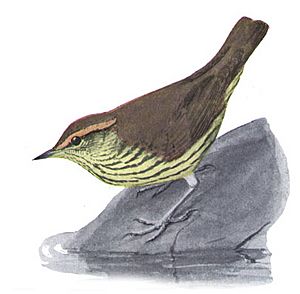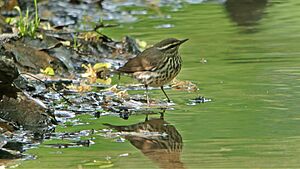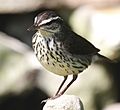Northern waterthrush facts for kids
Quick facts for kids Northern waterthrush |
|
|---|---|
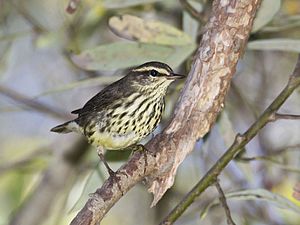 |
|
| Conservation status | |
| Scientific classification | |
| Genus: |
Parkesia
|
| Species: |
noveboracensis
|
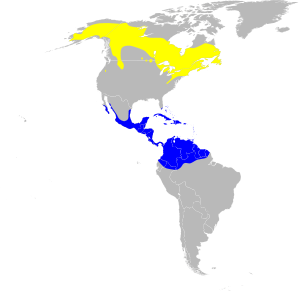 |
|
| Range of P. noveboracensis Breeding range Wintering range | |
| Synonyms | |
|
Seiurus noveboracensis |
|
The northern waterthrush (Parkesia noveboracensis) is a medium-sized songbird. It is a type of New World warbler. These birds travel long distances between their summer and winter homes.
They breed in the northern parts of North America. This includes Canada, the northern United States, and Alaska. When winter comes, they fly south. They spend winter in Central America, the Caribbean, and Florida. You can also find them in Venezuela, Colombia, and Ecuador. Sometimes, they are seen in other South American countries or western Europe, but this is very rare.
Contents
What's in a Name?
The name Parkesia honors Kenneth Carroll Parkes. He was an American bird expert and museum curator. The second part, noveboracensis, comes from New York City. It means "new York" in Latin. This is because the first bird of this kind was found there.
What Does a Northern Waterthrush Look Like?
The northern waterthrush is a large New World warbler. Even though its name has "thrush" in it, it is not a thrush. It grows to be about 12 to 15 centimeters (5 to 6 inches) long. Its wingspan is about 21 to 24 centimeters (8 to 9 inches). This bird usually weighs between 13 and 25 grams (0.5 to 0.9 ounces).
It has a brown head with a white stripe above its eye. This stripe is called a supercilium. Its beak is pointed and dark. The throat has light brown streaks. These streaks become darker and thicker on its chest and sides. Its back is a solid brown color. Male and female waterthrushes look very similar. Young birds have a creamy, yellowish color on their undersides instead of white.
People sometimes confuse the northern waterthrush with the Louisiana waterthrush. The Louisiana waterthrush has buff-colored sides and a buff-colored area under its tail. It also has bright pink legs. Its throat is whiter with fewer streaks. The Louisiana waterthrush is also a bit smaller and has a smaller beak. It has a narrower, darker eye-line and makes different sounds.
Both types of waterthrushes walk instead of hopping. They often bob their rear ends up and down as they move. This makes them look like they are teetering.
Northern Waterthrush Behavior
When northern waterthrushes spend winter in Puerto Rico, they fly up to 2 kilometers (1.2 miles) at night. They leave their daytime feeding spots to go to special places where they sleep. These sleeping spots are often in red mangrove forests.
Northern waterthrushes use four main types of habitats in Puerto Rico during winter. These are white mangrove, red mangrove, black mangrove, and scrub areas. Male waterthrushes are larger and fly north earlier in the spring. They prefer to spend winter in white mangrove areas. Here, they can keep or even gain weight during the winter. Females usually stay in the other drier habitats, which have less food.
Waterthrushes that winter in red and black mangrove areas can keep their body weight. However, those in scrub areas tend to lose weight. How much moisture is in their winter home also affects their weight gain.
Reproduction
Northern waterthrushes build their nests in wet woodlands near water. They often choose a tree stump or among tree roots. They build a cup-shaped nest using leaves, strips of bark, and small roots. The female lays three to six eggs. These eggs are cream or buff-colored with brown and gray spots.
What Do They Eat?
The northern waterthrush finds its food on the ground. It eats insects, snails and slugs, and crabs and shrimp. It searches for these small creatures among the fallen leaves on the forest floor.
Vocalization
The song of the northern waterthrush is loud and clear. It sounds like chirping notes that usually get lower in pitch and faster. The notes often come in pairs or groups of three. The song does not change much. Its call is a loud, strong "spwik" sound that rises in pitch. When it flies, it makes a buzzing, high, slightly rising "zzip" sound.
Images for kids
See also
 In Spanish: Chipe charquero para niños
In Spanish: Chipe charquero para niños



